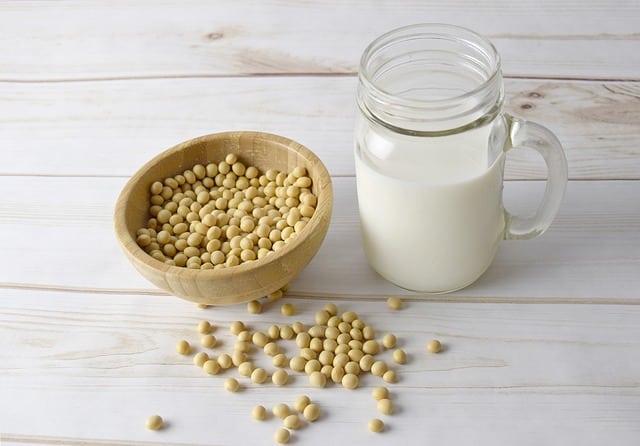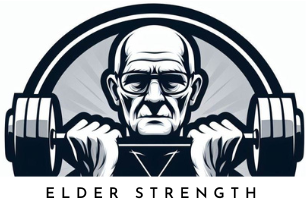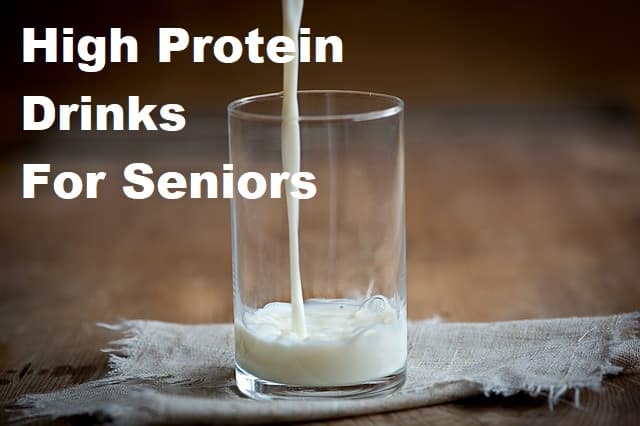Welcome friend! In this post, you will learn about the best high-protein drinks for seniors. We will talk about what’s important in a protein drink and what not to fall for from marketing hype.
Protein is a very important macronutrient for seniors but unfortunately many don’t get enough of it from food. As we age our energy expenditure and appetite can decline and protein is very satiating so many older people simply don’t feel like eating that much high-protein foods.
Protein helps to stave off age-related loss of muscle mass and because it fills you up, it also helps with weight control. That’s why it’s important to get at least the minimum daily recommendation from your diet.
If you are struggling to eat enough protein, protein drinks can be an easy solution. But it’s important to choose your protein drinks wisely, many of them are full of sugar, empty calories, and additives which can make you gain weight and be unhealthy in the long run.
The market is full of all kinds of ready-to-drink protein drinks but the truth is that simpler is always better. Regular milk or soy milk are great options and will talk a little bit about why. Another great option is whey protein powder that you can use to make your own protein drinks.
Let’s start by looking at what exactly are protein drinks and what you need to understand about them.
What Are Protein Drinks
A protein drink is any kind of drinkable beverage that has a high percentage of protein in it. But what exactly is protein?
As a fast recap if you are not familiar with macronutrients. All foods consist of three main macronutrients: carbohydrates, fats, and protein. Fiber can also be considered a macronutrient, but since pure fiber offers very little energy it’s not important for this topic.
Carbohydrate means things like starch and sugars and is typically your main source of energy. Think bread, potatoes, cereals, rice, fruit, etc.
Fats are important for all the tissues in your body and they also offer a very dense energy source, fat has over twice the calories of carbohydrates and protein. Fats can be found in milk, meat, fish, nuts, vegetable oils, etc.
Protein is the building block of life. This is what all your tissues use to repair and grow. Especially your skeletal muscles rely on sufficient protein to stay strong. Protein can also be used as energy by the body but your body will prefer carbs and fats over them unless you are starving since protein is so important for bodily functions.
Out of these three protein and fats are essential, meaning that you can’t survive without getting them from your diet in some form.
So protein drinks have a high amount of protein in them. All drinks are mainly water since all the nutrients have to be dissolved. This means that a high-protein drink can have somewhere between 3 to 15 percent of protein in them.
Many high-protein drinks also have other macronutrients in them. This is important to know because the amount of energy between two drinks that have similar amounts of protein can vary significantly if the other has a lot of carbs or fat in it. Just think of the difference between skimmed milk and whole milk. They have the same amount of protein, but whole milk has a ton more fat in it, which can multiply the energy density.
This is important if you are looking to just get more protein, not gain weight. On the other hand, if you are trying to gain (or struggling to maintain) weight, it is just as important to pick the high-calorie version.
If you want to learn more about why protein is so important for seniors, check out the article best protein supplements for seniors.
Just beware that saturated fat and sugar are often what is used to increase the calorie count, making these generally an unhealthy option. Which takes us to the next topic.
What To Look For In A Protein Drink
The market is full of “meal replacement” drinks that claim to have high protein content and are often marketed as health products.
When you go over their ingredients labeling (if they have one, depends on where you live) you will notice that they are often made mainly out of highly processed ingredients with a lot of additives.
Common ingredients are processed milk and soy proteins, sweeteners, sugar, palm oil, hydrogenated vegetable oils (= transfats, bad for you), artificial colorings, minerals, and vitamins.
It’s almost impossible to find a meal replacement drink or sports protein that doesn’t have at least sugar or sweeteners in it. Both of which you should avoid.
While drinks like these can be ok for protein supplementation in moderation, they shouldn’t be your go-to source of protein. One additional reason is that they are expensive.
There are natural options that don’t have unhealthy additives and have a lot better macronutrient distribution AND are a lot cheaper than most meal replacement protein drinks.
There are also very cheap yet clean and healthy protein powders that mix into a protein drink in a few seconds. They are a lot cheaper and healthier than the
All this comes with a certain price though, the taste. Most healthy protein drinks either taste very neutral or even a bit bitter, so they will not be as palatable as protein drinks that have been boosted with tons of sugar or sweeteners. But that’s the price you have to pay for a healthy diet.
It’s fine to use the sugary or artificial sweetener stuff every now and then as a treat, but it’s definitely not a good idea to get your daily protein from them.
Let’s look at the best healthy options.
Skimmed Milk
Yup, you read it right. Regular skimmed milk is a great source of protein. Since it’s skimmed, it will have most or all of the saturated dairy fat removed.
Skimmed milk basically consists of two macronutrients, protein (3-4%) and carbohydrate (4-5%). The protein consists of casein and whey, both extremely well-researched complete proteins that are generally accepted as one of the best sources of dietary protein.

A complete protein means that the protein includes all the essential amino acids that the body cannot synthesize. Some plant proteins aren’t complete, meaning that you will need to combine different sources to get all the building blocks for your body.
But since casein and whey are complete proteins with good bioavailability, they are great proteins for maintaining and building muscle mass.
The carbohydrate in milk is mostly in the form of lactose, which is technically a sugar but practically more like starch, especially when combined with protein like in milk. So you don’t really need to compare it to table sugar when concerned with health effects.
That said, many people are lactose intolerant, meaning that they lack the enzyme that’s responsible for digesting lactose, causing stomach upset, flatulence, and diarrhea. If you happen to be lactose intolerant, lactose-free skimmed milk is a great option.
The same goes for low-fat dairy products like yogurt, cottage cheese, skyr, and quarg (European sour fresh cheese with very high protein).
In some countries, dairy farming isn’t very well controlled, so it’s possible to get residual antibiotics and bovine growth hormones from dairy. That’s why it’s always a good idea to pay a little premium for a well-established branch or to buy organic if available.
Soy Milk
If you are vegetarian or vegan, low-fat soy milk is actually a great high-protein drink for seniors. With a few precautions.
Just like meal replacements, there are a ton of different kinds of soy milk on the market with very different compositions. All of them have soybean in them but there are also additives to make the milk more palatable and add nutritional value.
Soy milk is always processed to some degree but it’s possible to find brands that are mainly made out of soybeans with some fortified vitamins (mainly D and B12) and calcium.

What you need to look for besides the ingredients is the amount of sugar and fat. Many kinds of milk have a ton of added sugar to hide the beany taste (it’s an acquired taste but you get used to it) of soy. Many soymilks also have a high fat content.
My recommendation is to choose one that has as little sugar as possible and the fat should be depending on your dietary needs. In soy, the fat is mainly healthy unsaturated fat, so it’s not as high a risk as dairy fat.
There is a lot of controversies considering soy since it contains chemicals called phytoestrogens. They are natural compounds in soybeans that mimic the estrogen hormones of the body, being able to weakly activate the estrogen receptors of cells.
There have been quite a few studies done on the health effects of soy and the general consensus is that soy is completely safe to consume in moderate amounts. There should be no risk of adverse effects from the phytoestrogens unless you consume gallons of the stuff daily. Soy actually may offer some beneficial effects like reducing cholesterol and reduced risk of breast cancer, but the research is still inconclusive.
That said there’s another consideration for soy milk. It can be hard on the stomach and some people have trouble digesting it. Then again, most people can consume it in moderation without any trouble so the only way to find out is to test it.
Soybean protein is a complete protein just like milk, so it can be used as a protein supplement alone.
Whey Protein
This last one is a tried and true cheap alternative for expensive protein drinks. Plain whey protein concentrate is cheap, effective, and neutral-tasting.
Whey comes from dairy as I mentioned in the skimmed milk chapter. Whey is the water-soluble protein that is typically leftover when making curd for cheese.
Whey used to be thrown away or made into animal fodder until the bodybuilding community realized it was a dirt-cheap source of high-quality protein.
Whey has probably been researched more extensively than any other dietary protein supplement and the evidence for its benefit in improving and maintaining muscle mass is very clear.
Whey protein comes in many forms and flavors. My recommendation is to stick to high-quality unflavored whey protein concentrate. The taste of concentrate is neutral and artificial flavorings generally taste bad and can have adverse health effects. Whey isolates are usually a lot more expensive and taste pretty horrible, without any significant benefit over concentrate.
Whey concentrate powder is really easy to make into a protein drink. Just use a protein shaker to add water and shake for a minute and the powder will dissolve completely into the water.
With protein powders, it’s important to pick well-known manufacturers that have good quality control. Whey can have residual stuff from dairy but in a concentrated form. So it’s important that the whey is made from clean milk with good quality control.
Conclusion
I hope you found these tips for the best high-protein drinks for seniors useful. If you have any questions, feel free to leave them in the comments section below and I’ll get back to you.
As a recap: meal replacement and fitness protein drinks can be an attractive source of protein since they often are very sweet and tasty, but the truth is that they often are full of empty calories and additives.
You should get most of your protein from more natural and plain sources instead. It’s healthier and cheaper so it’s a win-win.
Milk, soy milk, and whey protein are all very good and well-researched protein supplements that are suitable for most people, no matter what your age is.
The downside is that as plain they will not be as tasty as ready-made protein drinks, but it’s very easy to get used to them, especially if you drink them with your dinner.
That’s it for today! Thanks for reading and see you next time.


Where in this article can I find the 3 most affordable protein drinks that you stated are in it?
Hi kathy! The recommendations are in the chapters. I didn’t include links to brands as my recommendations are skimmed milk, soy milk and whey protein. These can be found in most grocery stores so you can just pick the most affordable ones for you locally. Check out the article for best protein supplements if you are interested in specific protein supplements. I hope this helps!